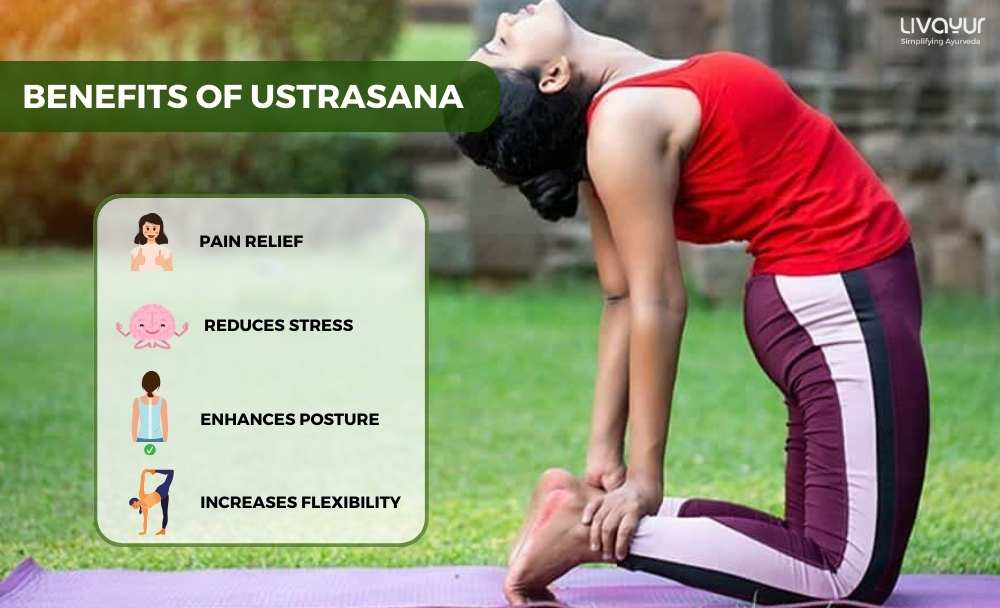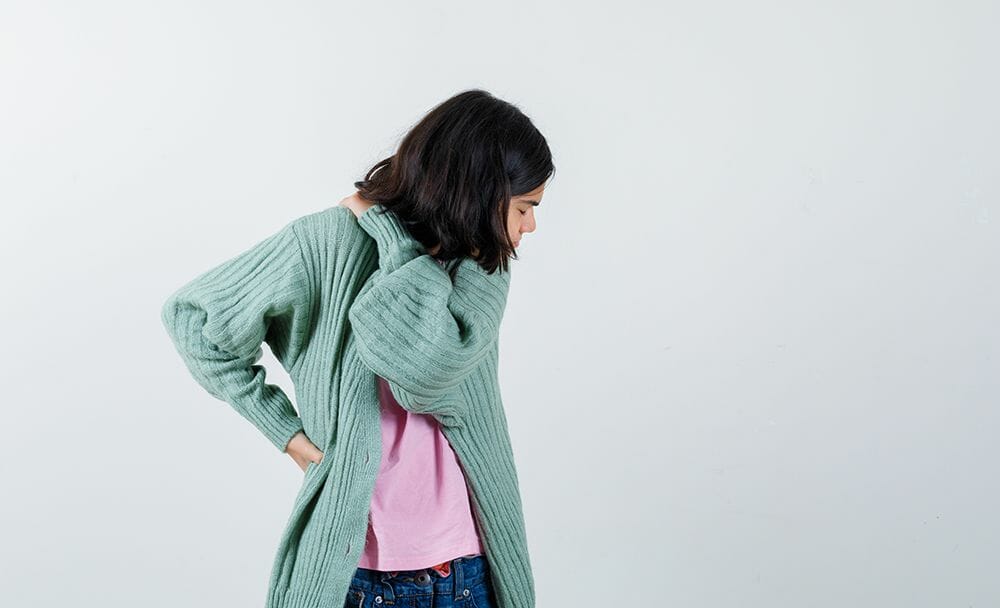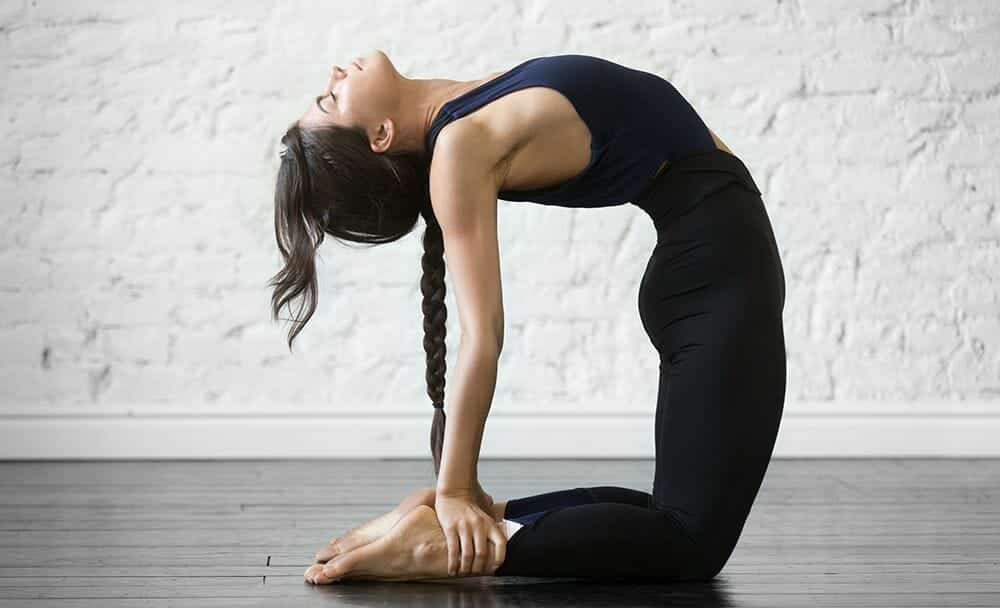
Ustrasana, also known as Camel Pose, is a popular yoga asana that offers a range of physical, mental, and emotional benefits. This back-bending pose is named after the graceful and powerful arch of a camel’s back. Ustrasana is known for its ability to open up the chest, shoulders, and hip flexors while providing a deep stretch to the front of the body and stimulating the nervous system. The practice of backward bending poses alleviates back pain by effectively stretching the back muscles and improving the muscle strength. This pose exerts notable pressure on the spine, triggering heightened nervous system stimulation and fostering enhanced neck and spine suppleness. [1]
The Camel Pose, recognized for its capacity to alleviate stress and anxiety, is a therapeutic posture beneficial for various spinal conditions. Therefore, there have been studies on the synergistic impact of Ushtrasana on Katishula (low back pain) in conjunction with Manyashula (neck pain). [1]
Ushtrasana, according to Ayurveda, is known to balance and calm the vitiated Apana Vayu. Since this dominates the lower parts of the body, it rectifies the imbalances apana vayu apart from balancing the Udana Vayu and Vyana Vayu. [2]
In this article, we will explore the various Ustrasana benefits and provide a step-by-step guide on performing it correctly.
Benefits of Ustrasana
Discomfort Alleviation (Pain):
As a result of the inherent steadiness (Sthiratwa) and the property of pacifying Vata (Vata Shamana Guna) within the Asana, heightened Vata conditions are mitigated, resulting in easy pain relief. The distress, rigidity, and constriction of spinal movement stem from structural transformations in the joint. So the main Ustrasana ke fayde or Ustrasana benefits in Hindi are the combined influence of stability (Sthiratwa), pacification of Vata (Vata Shaman), and strengthening of bones (Asthi pushti) contributes to the alleviation of Katishula (low back pain) and Manyashula (neck pain). [1]
Stiffness Reduction (Stambha):

The mild elongation of both muscles and joints during Ustrasana yoga yields the release of muscular tension, culminating in increased flexibility. This process aids in the dissipation of rigidity. [1]
Sensation of Prickling (Toda):
Consistent practice of Ustrasana yields a natural rectification of posture, leading to relaxation within taut muscles and the restoration of an unimpeded flow of Vata in the lower back region (Kati pradesha). Consequently, intensified Vata qualities such as mobility (Chala), dryness (Ruksha), prickling sensations (Toda), and lightness (Laghu) are attenuated. [1]
How to Do Ustrasana Step by Step:

Step 1:
Begin the Ustrasana steps by placing your knee on the ground, ensuring that your knees and thighs are in close proximity and that your toenails are gently resting on the floor.
Step 2:
Extend your toes backward. Position your palms on your buttocks, orienting your fingers towards your feet. Your elbows should point in the backward direction, and you should experience a lifting sensation in the sternum bone, directed forward.
Step 3:
Create a stretch in your thighs and form a curvature in your spine, arching it backward and extending the ribs.
Step 4:
As you exhale, lower your left palm onto the left heel and your right palm onto the right heel. Try placing your palms on the soles of your feet, and press your feet using your palms. Maintain contact between your ankles and the floor.
Step 5:
Tilt your head backward and push your spine towards your thighs, which should ideally be perpendicular to the floor.
Step 6:
Engage your buttocks by contracting them, thereby further elongating the spine. Simultaneously, elongate your neck towards the back. Remain in this pose, inhaling and exhaling naturally.
Step 7:
Gradually release one hand at a time, allowing them to rest on your buttocks. Subsequently, sit down on the floor and relax. [1]
FAQs
• What does Ardha Ustrasana mean?
Ardha Ustrasana, also known as the half-camel pose, is a modified version of Ustrasana. In this variation, only one hand connects with the heel, while the other hand extends upwards towards the sky.
• What advantages does Purna Ustrasana offer?
The advantages of Purna Ustrasana encompass body relaxation, expansion of the thoracic and abdominal regions, and reinforcement of the muscles. This pose might aid in conditions such as asthma, hernia, headaches, and lower back pain.
• What are the precautions to be kept in mind while practicing Ustrasana?
➣ Caution is advised for individuals with sensitive knees when attempting Ustrasana, as it has the potential to cause discomfort and undue pressure.
➣ It is advisable not to delve into the deeper extents of the pose until your body attains the necessary flexibility.
➣ Initiate your practice with modifications and props to ensure a comfortable start.
➣ It is crucial to acknowledge and honor your body’s limitations, progressing gradually to experience the pose’s benefits fully.
➣ Those with neck, shoulder, or back injuries should postpone attempting Ustrasana until their injuries are fully healed.
➣ If reaching the heels is challenging, avoid straining by using a block or a chair for added support.
➣ It is crucial not to rush into the final posture abruptly, as this could strain the neck and lower back, potentially leading to discomfort and injury.
➣ Individuals who have recently undergone abdominal surgery should steer clear of this pose.
Conclusion
Ustrasana (Camel Pose) is a powerful yoga asana that offers many benefits for the body, mind, and spirit, as it can enhance physical flexibility, emotional well-being, and spiritual awareness. As with any yoga practice, it is important to approach Ustrasana with mindfulness, awareness, and patience. Regular practice under the guidance of a certified yoga instructor can help you safely and effectively incorporate this pose into your yoga routine, reaping its numerous rewards over time.
Disclaimer:
This article is written from a health and wellness perspective and is not medical advice. Kindly seek the help of a certified medical practitioner before initiating any treatment.
References:


















My coder is trying to convince me to move to .net from PHP. I have always disliked the idea because of the costs. But he’s tryiong none the less. I’ve been using WordPress on several websites for about a year and am anxious about switching to another platform. I have heard very good things about blogengine.net. Is there a way I can import all my wordpress content into it? Any kind of help would be greatly appreciated!